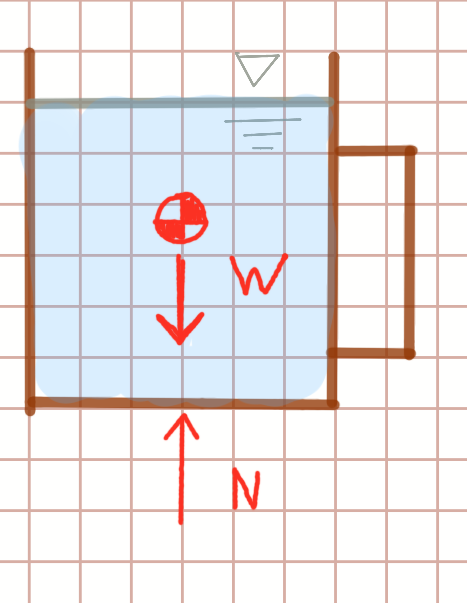Force
- id: 1685639928
- Date: Sept. 3, 2025, 4:30 p.m.
- Author: Donald F. Elger
Goals
- Describe a force.
- Skillfully use forces in applications.
What?
A force is a model of an interaction between two bodies, idealized as a push or pull acting at a point in a given direction.
Analysis: {model, interaction between two bodies, push or pull, point of application}
A force has two main features:
- Magnitude: how strong the push or pull is, measured
in units such as newtons (N) or pounds-force (lbf).
- Direction: the line along which the push or pull
acts.
Because a force always has both magnitude and direction, it is modeled as a vector. In practice, real forces may be spread out over areas, but in Statics we usual model them as if they act at a single point.
Example
Consider a cup of water sitting on a table. The sketch that follows shows how we might model the loads acting on the cup. This sketch, called a free-body diagram (FBD), shows the body (cup + water inside) isolated from its surroundings.
 There
are two loads on the cup, each modeled as a force.
There
are two loads on the cup, each modeled as a force.
\(W\): This is the weight of the cup and the woter. It is the pull on the (cup and water: body 1) from (the earth: body 2).
\(N\): This is push of the table (body 1) upward on the cup (body 2). The symbol \(N\) is commonly used because this force is called a Normal force.
The weight is shown acting a point. This point drawn to look like a pizza represent the center-of-mass of the cup and the water. In reality, the weight acts on each material element of the cup and the water, but for modeling purpose we idealize it as if the weight acts at the center-of-mass.
Note the table pushes up on each material element along the bottom of the cup. Again, we model this as if this push acts at a point in the center of the cup.
Line of Action
Force is typically modeled as a vector. If you draw a line on top of the vector, this line is called the line of action.
Application
Model most interactions that seem like a push or pull as a force.
Strive to identity the two interacting bodies.
When you see a force vector in a text book, indentify
Be skilled with converting force units, especially lbf and N.
Represent forces as vectors
What?
A force is a model of an interaction between two bodies that is idealized as a push or pull acting at a point in a direction aligned with the push or pull.
Analysis: {model, interaction of two bodies, push or pull, point}
Forces involves a magnitude (how large or a push or pull) that is measured in newtons (N), pounds-force (lbf), or other units.
Forces involve a direction, and they are modeled as vectors.
Examples
A person standing at ladder exerts a downward push. We would typically model this as a force which has a magnitude equal to the weight of the person. ![[person-on-ladder.png|200]].
Strong wind blowing a tall van might tip the van over. We typically model the push of the wind as a force. The magnitude of the force is easily calculated using the drag equation from fluid mechanics.
Facts
The SI unit of force is the Newton (N). Other common units are the pound-force (lbf).
Forces can be classified into two categories (cats):
Surface forces. The two bodies must be touching. Most forces are surface forces.
Body forces. This is a force that can act without the two bodies touching. Weight is a body force. A magnetic force and an electrostatic force are also body forces.
This classification is super-useful, especially for drawing free-body diagrams.
Forces are represented with vectors.
In mechanics, forces are often described in two ways:
Action force: A force that tends to cause a body to move.
Reaction force: A force that tends to cause a body to stay stationary.
This classification is used mostly in structures because building, bridges, and so on are not suppose to move. I don’t use these ideas, but many textbooks talk about reaction forces.
Tasks With Feedback (TwFs)
Define force as it is used in mechanics.
A force is an interaction between two bodies that can be characterized as a push or pull acting at a point.
For more detail see Force.
Context: A person is riding a bicycle. Give three or more examples of force.
- The push of the foot downward on the pedal.
- The pull of the bike chain on a gear attached to the rear wheel.
- The weight of the bicycle plus the rider.
- The push of the bike tire downward on the road.
Notice: Every example is the push or pull of one body on another.